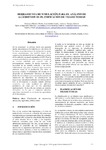Mostrar o rexistro simple do ítem
Herramienta de simulación para el análisis de algoritmos de planificación de trayectorias
| dc.contributor.author | Morales Martín, Francisco | |
| dc.contributor.author | Garrido Jurado, Juan | |
| dc.contributor.author | Vázquez Serrano, Francisco | |
| dc.contributor.author | Ruz Ruiz, Mario L. | |
| dc.date.accessioned | 2022-09-02T07:23:00Z | |
| dc.date.available | 2022-09-02T07:23:00Z | |
| dc.date.issued | 2022 | |
| dc.identifier.citation | Morales Martín, F., Garrido Jurado, J., Vázquez Serrano, F, Ruz, M. L. (2022) Herramienta de simulación para el análisis de algoritmos de planificación de trayectorias. XLIII Jornadas de Automática: libro de actas, pp. 777-784. https://doi.org/10.17979/spudc.9788497498418.0777 | es_ES |
| dc.identifier.isbn | 978-84-9749-841-8 | |
| dc.identifier.uri | http://hdl.handle.net/2183/31323 | |
| dc.description.abstract | [Resumen] En la actualidad, la robótica móvil está ganando mucha importancia en la industria, no solo dentro de las líneas de producción para la realización de ciertas tareas automatizadas, sino también dentro de la organización del material de los almacenes a través de los vehículos de guiado automático (AGV). Para la correcta actividad de estos dispositivos se necesita de un sistema embebido que controle todo el funcionamiento. Además, en muchas ocasiones, la necesidad de un tamaño reducido y un precio relativamente bajo para el usuario hace necesario abaratar costes en la producción. Por tanto, es necesario estudiar el rendimiento del sistema en el desarrollo de determinadas funciones de manera fluida. En este trabajo se presenta una herramienta de simulación de algoritmos de planificación de trayectorias típicamente utilizados en robótica móvil. Con la herramienta se pueden simular distintos escenarios, así como modificar los diferentes parámetros de cada uno de los algoritmos implementados. Se describe un conjunto de ejemplos ilustrativos en los que se comparan diferentes algoritmos, mostrando de este modo las capacidades de la herramienta. | es_ES |
| dc.description.abstract | [Abstract] Nowadays, mobile robotics is gaining importance in industry, not only within production lines for the performance of certain automated tasks, but also within the organization of material in warehouses through automated guided vehicles (AGVs). For the correct activity of these devices, an embedded system is needed to control the entire operation of the system. On many occasions, the need for reduced size and a relatively low price for the user makes it necessary to reduce costs in production. Therefore, it is required to study the performance of the system in the development of certain functions so that they are carried out fluidly. This work presents a simulation tool for path planning algorithms typically used in mobile robotics. The tool allows simulating different scenarios, as well as modifying the different parameters of each of the implemented algorithms. A set of basic illustrative examples are described and used to compare the performance of path planning algorithms and to show the capabilities of the presented tool. | es_ES |
| dc.language.iso | spa | es_ES |
| dc.publisher | Universidade da Coruña. Servizo de Publicacións | es_ES |
| dc.relation.uri | https://doi.org/10.17979/spudc.9788497498418.0777 | es_ES |
| dc.rights | Atribución-NoComercial-CompartirIgual 4.0 Internacional (CC BY-NC-SA 4.0) https://creativecommons.org/licenses/by-nc-sa/4.0/deed.es | es_ES |
| dc.rights.uri | http://creativecommons.org/licenses/by-nc/3.0/es/ | * |
| dc.subject | Planificación de trayectorias | es_ES |
| dc.subject | Simulación | es_ES |
| dc.subject | Algoritmos | es_ES |
| dc.subject | Robótica móvil | es_ES |
| dc.subject | Path planning trajectories | es_ES |
| dc.subject | Simulation | es_ES |
| dc.subject | Algorithms | es_ES |
| dc.subject | Mobile robot | es_ES |
| dc.title | Herramienta de simulación para el análisis de algoritmos de planificación de trayectorias | es_ES |
| dc.title.alternative | Simulation tool for the analysis of path planning algorithms | es_ES |
| dc.type | info:eu-repo/semantics/conferenceObject | es_ES |
| dc.rights.access | info:eu-repo/semantics/openAccess | es_ES |
| UDC.startPage | 777 | es_ES |
| UDC.endPage | 784 | es_ES |
| dc.identifier.doi | https://doi.org/10.17979/spudc.9788497498418.0777 | |
| UDC.conferenceTitle | XLIII Jornadas de Automática | es_ES |






